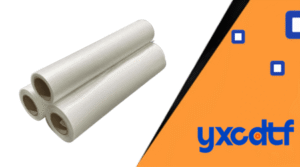Why PET Film Quality Matters
DTF PET film is more than a transfer carrier. It plays a crucial role in:
-
Holding the ink and powder in place during printing
-
Releasing cleanly after heat pressing
-
Ensuring durability of the final print
-
Preventing ghosting, ink bleeding, or cracking
📊 Fact Check:
In an internal study at YXCDTF, 72% of print defects (ghosting, smudging, partial transfers) were due to poor film coating, not ink or powder.
What Defines a High-Quality PET Film?
1. Uniform Coating
A premium PET film includes:
-
Anti-static layer to avoid powder scattering or curling
-
Oil-resistant layer for better ink absorption
-
Release layer for clean hot/cold peeling
🧪 Uneven coating = uneven transfers.
2. Accurate Thickness
The industry standard is 75μm ±2μm.
Too thin? Film curls or tears.
Too thick? Won’t feed properly into DTF printers.
3. Clean Peel Performance
-
Hot peel: peel immediately after pressing
-
Cold peel: wait 10–15 seconds
-
Hybrid: works across temperature ranges
🔍 Test Tip: Heat press at 160°C for 15 seconds. A premium film peels off in one clean stroke without residue.
4. Compatibility with Inks & Fabrics
A quality PET film must support:
-
Both CMYK and white ink
-
Cotton, polyester, blends, canvas, nylon
-
Good powder adhesion without clumping or dripping
5. Durability After Transfer
Top-grade PET films ensure:
-
Survive 50+ machine washes
-
Do not crack under stretching
-
Maintain color brilliance for months
🧪 Lab Test: YXCDTF PET films passed 55 industrial laundry cycles at 40°C with less than 2% color fade.
Key Specifications Checklist
| Specification | Recommended Range | Why It Matters |
|---|---|---|
| Thickness | 75μm ±2μm | Balance of strength and printer compatibility |
| Peel Type | Hot, Cold, Hybrid | Affects production speed and flexibility |
| Coating | Anti-static, Oil-resistant | Prevents ink bleeding and curl issues |
| Yellowing Resistance | ΔY < 1.0 (30 days UV) | Shelf stability and color preservation |
| Peel Strength | 120–150g/cm | Easier, cleaner release |
| Ink Absorption Speed | 5–10 sec | Avoids smearing during powdering |
| Residue After Peeling | <1% | Cleaner garments, better customer experience |
| Wash Durability | ≥50 washes | Maintains long-term print integrity |
👉 View full PET film specifications at YXCDTF
How to Test PET Film Before Buying in Bulk
1. Manual Peel Test
Print → Powder → Cure → Press → Peel
Check for: Tearing, residue, partial transfer
2. Wash Test
Apply to both cotton and polyester
Wash 10 times at 40°C
Check for fading, cracking, or lifting
3. Ink Absorption Test
Print a solid CMYK block with a white underbase
Smudging = poor ink hold
Dull color = weak coating
4. Fabric Compatibility Test
Test on the following:
-
Cotton
-
Polyester
-
Lycra
-
Canvas
-
Nylon
A good PET film should transfer cleanly on all types.
5. Anti-Static Test
Stack 10 sheets of printed film
If they curl or cling together — anti-static layer is insufficient
Signs of Low-Quality PET Film
Be cautious if you encounter:
-
Sticky film after pressing
-
Ink bleed at the edges
-
Cloudy or yellowish appearance
-
Uneven coating or dots
-
Strong chemical odor (cheap silicone/recycled base)
💡 Pro Tip:
Low-cost films often use recycled PET or weak coatings, leading to failed transfers, color fading, and long-term garment issues.
How YXCDTF Ensures Premium PET Film Quality
Manufacturing Standards
-
SGS & ISO9001 certified factory
-
Virgin PET base imported from Korea
-
Four-layer coating process
-
Daily sampling and internal QA testing
Performance Guarantee
-
Minimum 50-wash durability
-
Hot and cold peel options
-
Anti-oil & anti-static as standard
-
Guaranteed clean release
Batch Testing Includes:
-
Peel force
-
Ink bonding strength
-
Static levels
-
UV yellowing resistance
👉 Request your free sample pack today
Case Study: How a Spanish Distributor Avoided $20K Loss
A large DTF wholesaler in Spain faced recurring complaints about cracking and poor transfers. After switching to YXCDTF PET film, they saw:
-
Zero print issues for 3 months
-
26% faster production time
-
Customer satisfaction improved to 94%
🗣️ “YXCDTF film gave us consistency. Cheaper alternatives cost us in refunds and lost trust.”
— Rafael M., Importer, Spain
Choosing the Right PET Film for Your Business
| Business Type | Recommended Film Type | Why |
|---|---|---|
| High-volume apparel factory | Hot peel, 75μm, jumbo rolls | Compatible with automation & fast workflows |
| Custom print shops | Hybrid peel, A3 sheets | Flexible and easy to handle for varying designs |
| Nylon/Canvas use | Cold peel with stretch coating | Stronger bonding to textured materials |
| Entry-level DTF users | 100μm cold peel | Easier to handle, slower peel control |
👉 Explore PET film options from YXCDTF
Final Tips Before You Buy in Bulk
-
Always request SGS test reports
-
Ask for 3–5 sample sheets or rolls
-
Test on multiple fabric types
-
Confirm coating materials & film specs
-
Be cautious of ultra-low prices — they often mean poor coating or recycled base
📊 Fact Check:
PET films priced 20–30% lower than the market average often contain recycled PET chips or low-temperature silicone, which can cause major transfer failures.
Conclusion: Invest in Film, Save in the Long Run
High-quality PET film is the foundation of successful DTF printing. It impacts everything from speed to final garment quality and customer satisfaction.
With YXCDTF PET film, you get:
-
Reliable and consistent transfers
-
Stronger prints that last
-
Faster production
-
Cleaner release with less rework
-
SGS-certified product backed by performance testing
📞 Want to upgrade your PET film supplier?
👉 Contact the YXCDTF team today for pricing and samples

